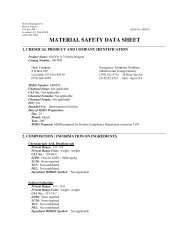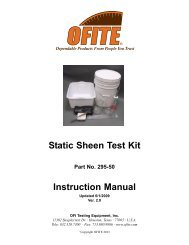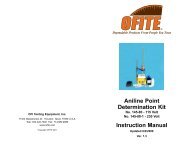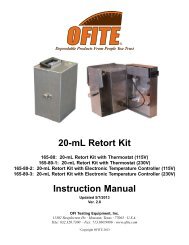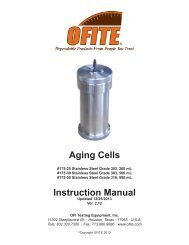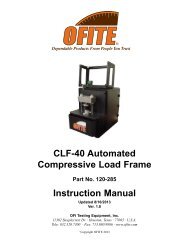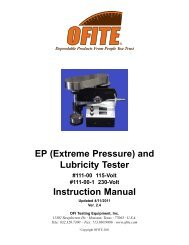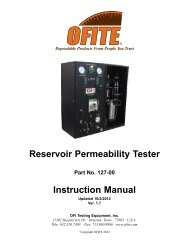Instructions - OFI Testing Equipment, Inc.
Instructions - OFI Testing Equipment, Inc.
Instructions - OFI Testing Equipment, Inc.
You also want an ePaper? Increase the reach of your titles
YUMPU automatically turns print PDFs into web optimized ePapers that Google loves.
<strong>OFI</strong> <strong>Testing</strong> <strong>Equipment</strong> – 146-00 <strong>Instructions</strong> – Workover and Completion Fluids Test Kit Page 8 of 17<br />
#153-36 Pipette, 2.0 ml x 1/10 ml, glass<br />
#153-38 Pipette, 5.0 ml x 1/10 ml, glass<br />
#153-40 Pipette, 10.0 ml x 1/10 ml, glass<br />
#153-51 Beaker, 250 ml, glass<br />
#168-01 Hot Plate, with Thermostat, 115 volt (Optional)<br />
(Required if the filtrate is colored)<br />
or<br />
#168-01-1 Hot Plate, with Thermostat, 230 volt (Optional)<br />
Reagents:<br />
#205-12 Titration sol'n (EDTA), Ver. Hard., 0.01M, 400 Mg/L, 16 oz<br />
#205-14 Calcium Buffer sol'n (NaOH), 1N, 2 oz<br />
#206-02 Deionized Water, 16 oz<br />
#210-00 Calver ® II Indicator Powder, 10 gram<br />
#230-25 Acetic Acid, Glacial, 8 oz (UN2789) (Optional)<br />
#261-00 Sodium Hypochlorite sol'n, 8 oz (UN1791) (Optional)<br />
#261-50 Masking Agent, 1:1:2 mixture by volume of<br />
Triethanolamine: Tetraethylenepentamine : Water, 16 oz<br />
(Optional)<br />
Procedure:<br />
WORK IN AN ADEQUATELY VENTILATED AREA.<br />
1. Using a pipette add at least 1.0 mL of sample to the Beaker. This volume will be used in the calculation<br />
formula below.<br />
If the filtrate is colorless or is only slightly colored, omit steps 2 - 5.<br />
2. Add 10.0 ml of Sodium Hypochlorite solution and mix.<br />
3. Add 1.0 ml of Glacial Acetic Acid and mix.<br />
4. Boil the sample for 5 minutes and maintain the sample volume by adding deionized water as required during<br />
boiling. Boiling removes excess Chlorine and this may be verified by immersing a strip of pH paper in the<br />
sample. If the paper is bleached white, continue boiling. A sufficiently boiled sample will have a pH of 5.0.<br />
5. Cool the sample and wash the sides of the beaker with deionized water.<br />
6. Using deionized water, dilute the sample to approximately 50 ml.<br />
7. Add 10 to 15 ml of Calcium Buffer solution, or sufficient Buffer solution to produce a pH of 12 - 13.<br />
Note: The presence of soluble Iron may interfere with the endpoint determination. If this is suspected, a mixture of<br />
Triethanolamine: Tetraethylenepentamine: Water (1:1:2 by volume) is a suitable masking agent.<br />
Add 1 ml of the mixture at this point.<br />
8. Add sufficient Calver ® II Indicator powder (0.1 to 0.2 grams) to produce a pink to wine-red color if<br />
Calcium is present. Too much indicator will obscure the endpoint. Note: Adding several drops of<br />
Methyl Orange Indicator solution may improve the visibility of the endpoint.<br />
9. While stirring, titrate with Hardness Titration solution (EDTA), to the end point. Calcium indicators produce a<br />
Red-to-Blue change and the endpoint is best described as that point where additional Titration solution will<br />
<strong>OFI</strong>TE • 11302 Steeplecrest Dr. • Houston, TX 77065 USA • Phone (832) 320-7300 • http://www.ofite.com<br />
Version 1.1<br />
Date 03-04-03



